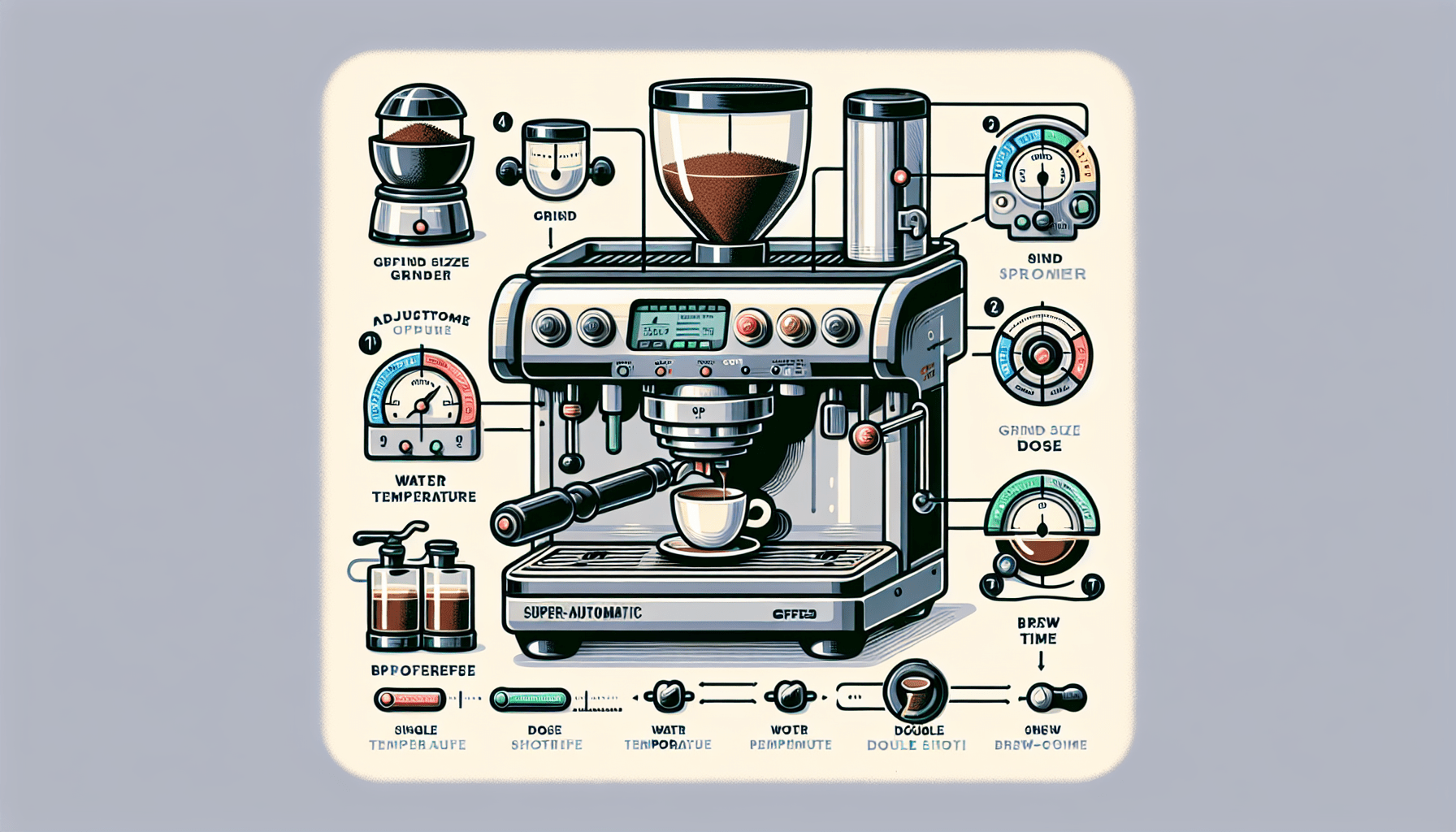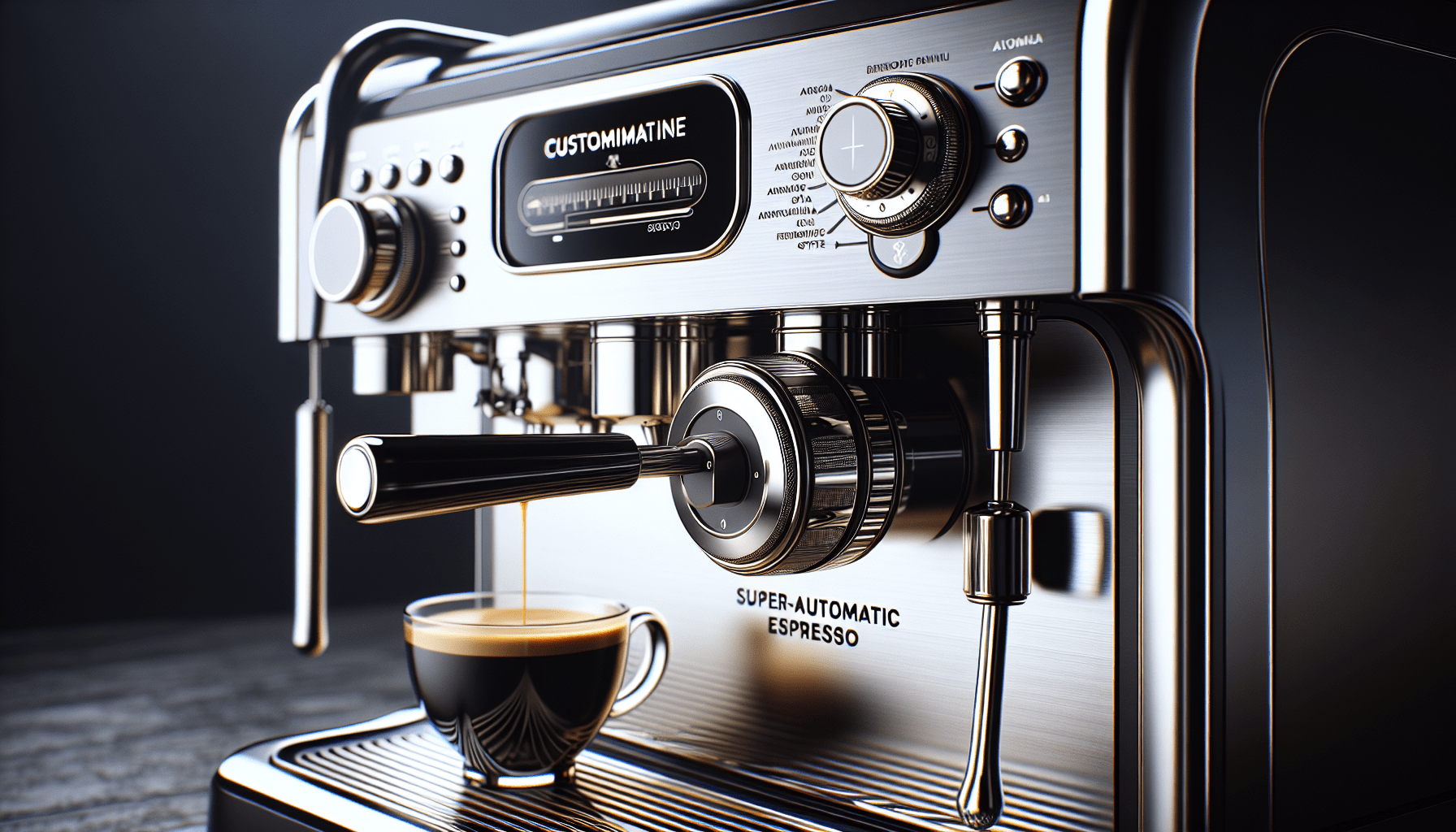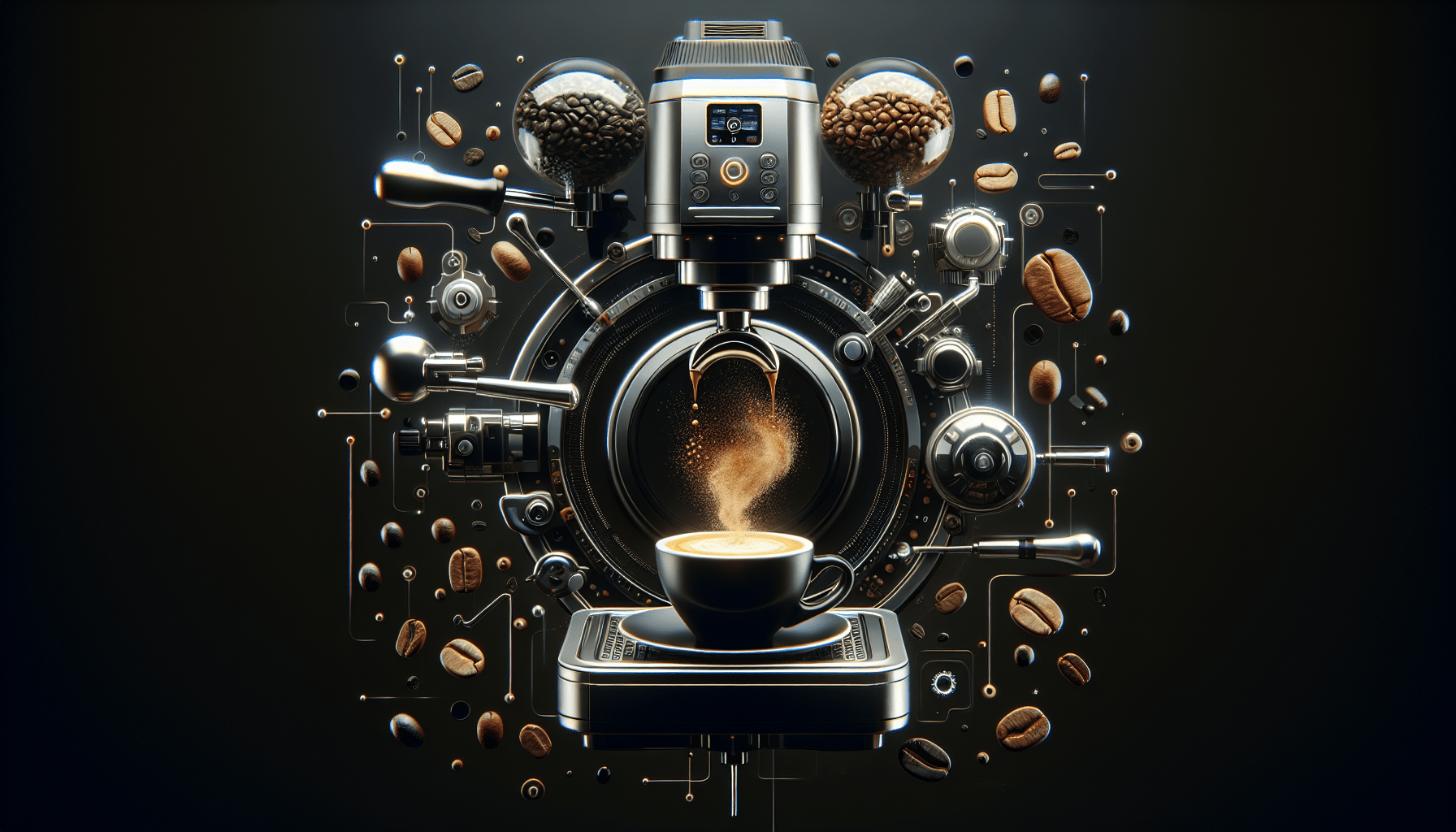In the world of super-automatic espresso machines, the key component that ensures a perfect cup of coffee every time is the grinder. But have you ever wondered about the different types of grinders that are used in these machines? From burr grinders to blade grinders, there are various options available, each with its own unique advantages. In this article, we will explore the different types of grinders used in super-automatic espresso machines, helping you understand which one is best suited for your coffee needs. So, whether you’re a coffee aficionado or simply someone who loves a great cup of joe, read on to discover more about these fascinating grinders that are at the heart of our beloved super-automatic espresso machines.
Burr Grinders
Overview of Burr Grinders
When it comes to grinding coffee beans, burr grinders are widely recognized as the top-quality option. Unlike blade grinders that chop the beans unevenly, burr grinders crush the beans between two plates, resulting in a consistent and uniform grind. This consistency ensures that the flavor and aroma of your coffee are maximized, allowing you to truly savor every sip.
Conical Burr Grinders
One type of burr grinder is the conical burr grinder. As the name suggests, these grinders feature a cone-shaped grinding mechanism that ensures a more precise and even grind. The cone shape of the burrs allows for a longer grinding surface area, which ultimately leads to a more efficient and consistent coffee grinding process. Conical burr grinders also tend to produce less heat during the grinding process, thereby preserving the integrity of the coffee beans and preventing any burnt or bitter flavors from seeping into your brew.
Flat Burr Grinders
Another type of burr grinder is the flat burr grinder. Unlike conical burr grinders, flat burr grinders have two flat plates that grind the coffee beans. While this may sound less sophisticated, flat burr grinders are known for producing a very consistent grind size, resulting in a well-balanced and flavorful cup of coffee. Flat burr grinders are often favored by espresso enthusiasts due to their ability to produce a fine and consistent grind for espresso extraction.
Blade Grinders
Overview of Blade Grinders
Blade grinders, on the other hand, are a more affordable and common option for grinding coffee beans. These grinders operate by chopping the beans with a spinning blade, resulting in an uneven grind. While blade grinders may be convenient and quick, they often produce coffee grounds of varying sizes, leading to inconsistent extraction and a less-than-ideal coffee experience. If you are looking for a more refined and flavorful cup, it is generally recommended to invest in a burr grinder rather than a blade grinder.
Pros and Cons of Blade Grinders
Despite their limitations, blade grinders do have a few advantages. Firstly, they are typically more affordable than burr grinders, making them a budget-friendly choice for coffee enthusiasts. They are also compact and easy to use, making them a popular option for those who prioritize convenience. However, it is important to note that the inconsistent grind produced by blade grinders can result in a less satisfying and flavorful cup of coffee. Additionally, blade grinders tend to generate more heat during the grinding process, which can affect the quality and taste of the coffee.
Ceramic Grinders
Benefits of Ceramic Grinders
Ceramic grinders have gained popularity in recent years due to their exceptional grinding capabilities. Ceramic burrs are known for their durability and ability to maintain sharpness over time. Unlike steel burrs, ceramic burrs do not rust or corrode, ensuring longevity and consistent performance. Additionally, ceramic grinders produce less heat during the grinding process, which helps to preserve the delicate flavors and aromas of the coffee beans. If you value precision and longevity in your coffee grinder, a ceramic grinder may be the perfect choice for you.
Drawbacks of Ceramic Grinders
While ceramic grinders have many benefits, there are a few drawbacks to consider. Firstly, ceramic burrs are generally more expensive than their steel counterparts, making them a pricier investment. Additionally, ceramic grinders can be more susceptible to chipping or cracking if mishandled or dropped, which could potentially affect the grinding performance. However, with proper care and maintenance, ceramic grinders can provide a superior grinding experience that elevates your coffee brewing routine.
Steel Grinders
Advantages of Steel Grinders
Steel grinders, particularly stainless steel grinders, offer their own set of advantages. Firstly, steel burrs are typically more affordable than ceramic burrs, making them a cost-effective option for coffee enthusiasts. Stainless steel grinders are also highly durable and resistant to wear and tear, ensuring a long and reliable lifespan. Furthermore, steel grinders are generally easier to clean and maintain, as they are less prone to staining or developing residue over time. If you are looking for a reliable, budget-friendly option, a steel grinder may be the perfect fit for you.
Disadvantages of Steel Grinders
While steel grinders have their advantages, they are not without their limitations. One drawback is that steel burrs can generate more heat during the grinding process compared to ceramic burrs, which may affect the overall flavor and quality of the coffee. Additionally, steel burrs may have a slightly greater tendency to dull over time, requiring more frequent maintenance and sharpening. However, with regular care and attention to proper grinding techniques, these potential downsides can be mitigated, allowing you to enjoy a flavorful and consistent cup of coffee.
Adjustable Grinders
Importance of Adjustable Grinders
One key feature to consider when choosing a grinder is adjustability. Adjustable grinders allow you to control the grind size, which is crucial for achieving the optimal brewing parameters for different coffee brewing methods. Whether you prefer a coarse grind for French press or a fine grind for espresso, an adjustable grinder provides the flexibility to meet your specific brewing needs. Being able to customize the grind size allows you to unlock the full potential of your coffee beans and extract the desired flavors and aromas.
How Adjustable Grinders Work
Adjustable grinders typically have a dial or a sliding mechanism that allows you to choose from a range of grind settings. These settings can vary from coarse to fine, enabling you to experiment and find the ideal grind size for your coffee brewing method. By adjusting the distance between the burrs or blades, you can finely tune the grind size to achieve consistent results. It is important to note that different coffee grinders may have different mechanisms for adjusting the grind size, so it is recommended to consult the manual or manufacturer’s instructions for your specific grinder.
Grind Settings
Quality of Grind Settings
The quality of the grind settings on your grinder can have a significant impact on the overall flavor and extraction of your coffee. Grinders with precise and well-defined grind settings allow you to replicate the desired grind size consistently. This consistency is crucial for ensuring that each coffee particle is evenly extracted, resulting in a balanced and flavorful cup of coffee. Ideally, the grind settings on your grinder should be clear and easy to adjust, allowing for accurate and repeatable grinding performance.
Number of Grind Settings
The number of grind settings available on a grinder can vary significantly. Some grinders offer a limited number of predefined settings, while others provide a wider range of options for fine-tuning your grind size. The number of grind settings you need ultimately depends on your coffee brewing preferences and the brewing methods you use most frequently. If you enjoy experimenting with different brewing techniques or using a variety of coffee beans, a grinder with more grind settings may be beneficial. However, for those who have a preferred brewing method and stick to a consistent grind size, a grinder with fewer settings may be more than sufficient.
Grind Size Consistency
Importance of Grind Size Consistency
Achieving grind size consistency is an essential factor in brewing high-quality coffee. Consistent grind size ensures that each coffee particle is extracted evenly, resulting in a well-balanced and flavorful cup. When the grind size is inconsistent, some particles may be over-extracted, leading to bitterness, while others may be under-extracted, resulting in a weak and lackluster coffee. Therefore, investing in a grinder that offers excellent grind size consistency is crucial for unlocking the full potential of your coffee beans and brewing a consistently delicious cup of coffee.
Factors Affecting Grind Size Consistency
Grind size consistency can be influenced by several factors. Firstly, the quality and design of the grinder’s burrs or blades play a significant role. Higher-quality grinders tend to have more precisely machined burrs or blades, resulting in a more even and consistent grind. The stability and alignment of the grinder’s internal components, such as the burr or blade holder, also contribute to grind size consistency. Additionally, the grinding speed and technique employed can impact the consistency of the grind. Slower grinding speeds and steady movements help to maintain a consistent particle size, while rapid or uneven grinding can result in inconsistency. Lastly, the type and freshness of the coffee beans used can affect grind size consistency, as different beans may have varying levels of hardness or density.
Grind Speed
Impact of Grind Speed on Flavor
The speed at which a coffee grinder operates can affect the flavor and quality of the coffee. Grinding coffee at a high speed can generate heat and friction, which may cause the coffee grounds to become overheated and potentially result in a burnt or bitter taste. Conversely, grinding at a slower speed reduces the heat generated, helping to preserve the delicate flavors and aromas of the coffee beans. Therefore, it is generally recommended to choose a grinder that offers a slower and more controlled grinding speed for optimal flavor extraction.
Effects of Grind Speed on Equipment
Not only does grind speed affect the flavor of the coffee, but it can also impact the overall performance and longevity of the grinder itself. Grinding at high speeds can put strain on the grinder’s motor and other internal components, potentially shortening its lifespan. In contrast, slower grinding speeds put less stress on the equipment, resulting in a more reliable and durable grinder. When choosing a grinder, it is important to consider the recommended grinding speed and ensure that it aligns with your desired flavor profile and equipment longevity.
Built-in Grinders vs. Separate Grinders
Pros and Cons of Built-in Grinders
Super-automatic espresso machines often come with the option of a built-in grinder. This integrated system offers convenience and space-saving benefits, as it eliminates the need for a separate grinder on your countertop. Built-in grinders also ensure that the coffee beans are ground fresh for each cup, allowing you to experience the freshest and most flavorful coffee possible. However, it is worth noting that built-in grinders may have limitations in terms of grind size consistency and adjustment options. Additionally, if the grinder component malfunctions or requires maintenance, it may impact the overall functionality of the espresso machine.
Benefits of Separate Grinders
On the other hand, opting for a separate grinder provides you with more control and flexibility in choosing the grinder that best suits your specific needs and preferences. Separate grinders often offer a wider range of grind settings, allowing you to fine-tune the grind size to your desired specifications. They also tend to provide better grind size consistency, which is essential for achieving the optimal extraction and flavor. Moreover, should the grinder component require repair or replacement, having a separate grinder allows you to continue using your espresso machine without interruption. While it may take up additional space on your countertop, investing in a separate grinder can be a worthwhile choice for those seeking ultimate precision and customization in their coffee brewing routine.
Maintenance and Cleaning
Cleaning Super-automatic Espresso Machine Grinders
Proper cleaning and maintenance of your super-automatic espresso machine’s grinder are crucial for ensuring optimal performance and longevity. Regular cleaning helps to prevent the buildup of coffee residue and oils, which can negatively impact the flavor and quality of your coffee. To clean the grinder, follow the manufacturer’s instructions, as the specific cleaning process may vary depending on the model. In general, it is recommended to use a soft brush or a grinder cleaning tablet to remove any leftover coffee particles. It is important to refrain from using water or any liquid cleaners near the grinder, as this can damage the internal components. By incorporating regular cleaning into your coffee routine, you can enjoy consistently delicious coffee and extend the lifespan of your super-automatic espresso machine.
Maintenance Tips
In addition to regular cleaning, there are a few maintenance tips to keep in mind when using a grinder. Firstly, be mindful of the type and quality of coffee beans you use, as oily or flavored beans can leave residue in the grinder and affect its performance. It is recommended to use freshly roasted and whole coffee beans for the best flavor and to minimize the risk of residue buildup. Additionally, check and replace the grinder burrs or blades as needed, as worn-out components can affect the grind size consistency. Lastly, always refer to the manufacturer’s instructions for specific maintenance recommendations, as each grinder may have unique requirements. By incorporating these maintenance tips into your coffee routine, you can ensure that your grinder operates at its best and consistently delivers delicious coffee.




